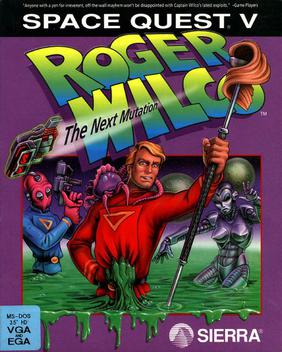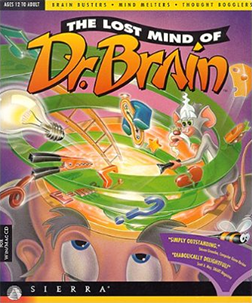
Day of the Tentacle, also known as Maniac Mansion II: Day of the Tentacle, is a 1993 graphic adventure game developed and published by LucasArts. It is the sequel to the 1987 game Maniac Mansion. The plot follows Bernard Bernoulli and his friends Hoagie and Laverne as they attempt to stop the evil Purple Tentacle - a sentient, disembodied tentacle - from taking over the world. The player takes control of the trio and solves puzzles while using time travel to explore different periods of history.

Indiana Jones and the Last Crusade: The Graphic Adventure is a graphic adventure game, released in 1989 by Lucasfilm Games, coinciding with the release of the film of the same name. It was the third game to use the SCUMM engine.
Dr. Brain is a series of educational games made by Sierra On-Line in the 1990s. The objective of each game is solving a series of puzzles in order to proceed further into the game. The series was later picked up by Knowledge Adventure who turned it into a more action-oriented game.

Freddy Pharkas: Frontier Pharmacist is a comic Old West adventure computer game created by Al Lowe and Josh Mandel and published by Sierra On-Line in 1993. It was dubbed "the Blazing Saddles of computer games" by Computer Gaming World.

King's Quest V: Absence Makes the Heart Go Yonder! is a 1990 graphic adventure game by Sierra On-Line. Originally released in November 1990, it featured a significant improvement in graphics. It was also the first King's Quest installment to replace the typing user interface with a point-and-click user interface. The title is a spoof on the proverb "Absence makes the heart grow fonder".

King's Quest VI: Heir Today, Gone Tomorrow is a point-and-click adventure game, first released in 1992 as the sixth installment in the King's Quest series produced by Sierra On-Line. Written by Roberta Williams and Jane Jensen, King's Quest VI is widely recognized as the high point in the series for its landmark 3D graphic introduction movie and professional voice acting. King's Quest VI was programmed in Sierra's Creative Interpreter and was the last King's Quest game to be released on floppy disk. A CD-ROM version of the game was released in 1993, including more character voices, a slightly different opening movie and more detailed artwork and animation.

The Coles is a colloquial term referring to Corey Cole and Lori Ann Cole, a husband and wife team who are both video game designers. Working together they designed the Quest for Glory series. They have also each designed games independently.

Tass Times in Tonetown is an adventure game published by Activision in 1986. It was designed by Michael Berlyn and Muffy McClung Berlyn and programmed by Rebecca Heineman of Interplay in cooperation with Brainwave Creations.

Rama is a first-person adventure game developed and published by Sierra On-Line in 1996. The game is based on Arthur C. Clarke's books Rendezvous with Rama (1973) and Rama II (1989) and supports both DOS and Microsoft Windows. In 1998, a PlayStation version was released in Japan. It is the second Rama game to be produced. The interactive fiction game Rendezvous with Rama was released in 1984 by Telarium.

The Guild of Thieves is an interactive fiction game by Magnetic Scrolls first published by Rainbird in 1987. The game takes place in Kerovnia like the previous game The Pawn.

Torin's Passage is a point-and-click adventure game developed and published by Sierra On-Line in 1995. The game was designed by Al Lowe, author of the Leisure Suit Larry series.

The Lost Files of Sherlock Holmes is an adventure game developed by Mythos Software and published by Electronic Arts for MS-DOS in 1992 and 3DO in 1994. A sequel was developed and published by the same respective companies in 1996 titled The Lost Files of Sherlock Holmes: The Case of the Rose Tattoo.

Space Quest IV: Roger Wilco and the Time Rippers is a 1991 graphic adventure game by Sierra On-Line. It was released on floppy disks on March 4, 1991, and released on CD-ROM in December 1992 with full speech support and featuring Laugh-In announcer Gary Owens as the voice of the narrator. It featured 256-color hand painted graphics and a fully mouse-driven interface. It was one of the first video games to use motion capture animation. It cost over US$1,000,000 to produce and sold more than its three predecessors combined. An Atari ST version was announced via Sierra Online's magazine, Sierra News Magazine, but was later canceled.

Space Quest V: Roger Wilco – The Next Mutation is a graphic adventure game released for MS-DOS on February 5, 1993.

Castle of Dr. Brain is an educational video game released in 1991 by Sierra On-Line. It is a puzzle adventure game.

Gabriel Knight: Sins of the Fathers is a 1993 point-and-click adventure game, developed and published by Sierra On-Line for MS-DOS, Macintosh, and Windows, and released on December 17, 1993. The CD-ROM version features the voice talents of Tim Curry, Mark Hamill, Michael Dorn, Efrem Zimbalist Jr., and Leah Remini. The game's story focuses on Gabriel Knight, a struggling novelist and owner of a rare book store in New Orleans, who opts to research a recent spate of murders around the city that have a connection to voodoo. In the process, he is slowly revealed to be a descendant of a German family who are involved in combatting people who use supernatural forces, and discovers a link between the killings and his family's past.

The text adventure game Spellcasting 301: Spring Break is the third and last installment of the Spellcasting series created by Steve Meretzky during his time at Legend Entertainment. All three games in the series tell the story of young Ernie Eaglebeak, a student at the prestigious Sorcerer University, progressing through his studies, learning the arcanes of magic, taking part in student life, occasionally saving the world as he knows it, and having his way with any beautiful women he can get his hands on.

The Lost Mind of Dr. Brain is the third installment of the original Dr. Brain series, which were educational games published by Sierra On-Line.

Where in Space Is Carmen Sandiego? is an educational video game by Broderbund and Electronic Arts.

Smart Games Challenge is a video game series developed by American companies KnowWare and Smart Games. Three games were released between 1996 and 1998.



















